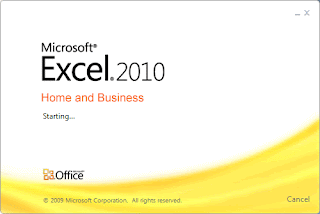FEATURES | EXCEL 2010 NEW FEATURES OVER EXCEL 2007
● 64-bit version: If your hardware supports it, you can install the 64-bit version, which lets you create much larger workbooks.
● Sparkline charts: Create small, in-cell charts to summarize a range of data graphically.
● Pivot table Slicers: A new way to filter and display data in pivot tables.
● Pivot table formatting options: You have more control over the appearance of pivot table reports.
● File tab: The File tab replaces the Office
button, which is located to the left of the other
tabs. Clicking it displays Backstage View, a screen that lets you perform various operations on your workbook. This view essentially replaces the traditional File and Print menus — plus quite a bit more.
● Draft mode for charts: If you use many highly formatted charts, you can choose to display them in draft mode for improved performance.
● Conditional formatting enhancements: Data bar conditional formatting can display in a
solid color, and the bars provide a more accurate display.
● Function enhancements: Many of Excel’s statistical functions have been improved in terms of numeric accuracy. The old versions of these functions are still available and have been relegated to a new function category called Compatibility.
● Image editing enhancements: You have much more control over the appearance of
graphic images inserted into a workbook.
● Paste preview: When you copy a range, the Paste command displays various options
(with preview).
● Ribbon customization: End users can customize the Ribbon by adding new tabs and groups.
● Equation editor: Create and display (noncalculating) mathematical equations.
● Faster processing: Microsoft made some improvements to the calculation engine, and files load a bit faster.
● New security features: Workbooks downloaded from the Internet or from e-mail attachments are opened in Protected View mode. Workbooks can be designated as “trusted,” and they don’t need to reside in special trusted folders.
● Updated Solver: Excel 2010 includes a new version of the Solver add-in.
● Enhancements to VBA: Many operations that used to require old XLM macros can now be performed directly using VBA macro commands.
● Sparkline charts: Create small, in-cell charts to summarize a range of data graphically.
● Pivot table Slicers: A new way to filter and display data in pivot tables.
● Pivot table formatting options: You have more control over the appearance of pivot table reports.
● File tab: The File tab replaces the Office
button, which is located to the left of the other
tabs. Clicking it displays Backstage View, a screen that lets you perform various operations on your workbook. This view essentially replaces the traditional File and Print menus — plus quite a bit more.
● Draft mode for charts: If you use many highly formatted charts, you can choose to display them in draft mode for improved performance.
● Conditional formatting enhancements: Data bar conditional formatting can display in a
solid color, and the bars provide a more accurate display.
● Function enhancements: Many of Excel’s statistical functions have been improved in terms of numeric accuracy. The old versions of these functions are still available and have been relegated to a new function category called Compatibility.
● Image editing enhancements: You have much more control over the appearance of
graphic images inserted into a workbook.
● Paste preview: When you copy a range, the Paste command displays various options
(with preview).
● Ribbon customization: End users can customize the Ribbon by adding new tabs and groups.
● Equation editor: Create and display (noncalculating) mathematical equations.
● Faster processing: Microsoft made some improvements to the calculation engine, and files load a bit faster.
● New security features: Workbooks downloaded from the Internet or from e-mail attachments are opened in Protected View mode. Workbooks can be designated as “trusted,” and they don’t need to reside in special trusted folders.
● Updated Solver: Excel 2010 includes a new version of the Solver add-in.
● Enhancements to VBA: Many operations that used to require old XLM macros can now be performed directly using VBA macro commands.


0 comments for "FEATURES | EXCEL 2010 NEW FEATURES OVER EXCEL 2007"